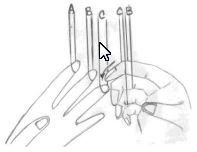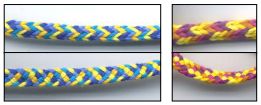You may want to try the Finger Loop Braiding. I found this article a couple of years ago and decided to post here for those who are interested with fingerloop braiding just like the kumihimo braiding patterns we have discussed here.
(Original article from)
Fingerloop Braiding Workshop Blue Skies ’09
by: Gillian Woodruff
Fingerloop braiding has been practiced in various forms for thousands of years around the globe, reaching a peak of refinement in medieval Europe when silk braids were made for laces, purse strings and other adornments. The translation of some old English pattern manuscripts over the last 20 years has renewed interest in this method.
The braiding is performed with fingers holding loops of thread whose loose ends are anchored together. Loops are pulled through others by exchanging them between fingers in a specific way to produce a braided structure. A surprisingly wide variety of braids are possible using this method. Commonly, 5 to 8 loops are worked with 2 hands (although anywhere from 2 to 11 are possible) and larger braids can be made by having two or more braiders working simultaneously. We are starting with one of the simpler 5 loop braids in this workshop (Braid 1 below, the “double herringbone”).
Since a 5 loop braid has 10 interlaced threads, complex-looking braids can be made fairly quickly and easily(with a little practice). However, some downsides are: the worked length is limited by an arm-span (arms must be spread to tighten the braid after each move); the worker must be anchored to the work (although loops can be placed in a holder to pause the work); and it can be very hard to recover without error from dropped loops!
Setting Up A 5-Loop Braid
- Cut 5 threads each approx. 1 m (40 in) long.
- Align the ends and fold thread bundle in half; tug on folded end (the loops) while holding loose ends together to smooth out threads and ensure all loops are the same length.
- Tie an overhand knot near the loose ends, and (optionally) another knot a pencil-width apart to create an anchoring/closure loop.
- Anchor the knotted end to a fixed point (e.g. tree, rail, table leg, foot, toe…) with some string, or insert a stick to be held by a partner (or between your knees or toes).
- Place one loop on each finger:

- Left Hand (Lh): Index (A); Middle (B); Ring (C)
- Right Hand (Rh): Middle (B); Ring (C)
- Pattern guidelines:
- Checks: group all dark colours on one hand, all light on the other
- Stripes: place same colour on Lh A and Lh C
- Gradations: place in lightest-to-darkest order: Lh A → Lh B →Lh C →Rh B →Rh C
Braid 1: Double Herringbone (or “Half-Round”) Braid
One of the easiest and most forgiving 5-loop braids. This braid is fairly flat (half-round in cross-section). One side looks woven while the other looks like two side-by-side herringbone braids. Hooking loop C from below as shown will twist the loop so that its lower thread becomes its upper thread after the transfer. The braiding moves are the same from the right and left sides:
 |
| Move 1. Hook Lh C from below |
- Rh: pass A through B, hook Lh C from below
- Lh: “walk down” loops (move loop on B to C, and loop on A to B)
- Lh: pass A through B, hook Rh C from below
- Rh: “walk down” loops (move loop on B to C, and loop on A to B)
- Repeat 1. – 4.
Braid 2: Square Braid
A more challenging braid because the picking index finger (A) must pass through BOTH loops on the same hand (B and C) before hooking loop C as before. The braid is square in cross-section, with a herringbone pattern showing along all 4
sides. The braiding moves are again the same from the right and left sides.
- Rh: pass A through B & C, hook Lh C from below*
- Lh: “walk down” loops
- Lh: pass A through B & C, hook Lh C from below*
- Rh: “walk down” loops
- Repeat 1. – 4.
*TIP for all moves like 1. & 3.: Use your thumb with A to help get the hooked loop back through B and C.
Braid 3: Split Braid
This is a great way to simultaneously braid two identical 5-thread herringbone braids, and only a few moves of this braid will create an opening for a closure or design interest. The picking index finger (A) must again pass through BOTH loops on the same hand (B and C) before hooking loop C on the other hand. However, the loop is now hooked by passing the picking finger A inside the loop C such that the bottom thread is below the picking finger A and gets hooked from above (instead of from below). Hooking loop C from inside as shown will keep the loop untwisted so that its lower thread remains so after transfer. The braiding moves are the same from the right and left sides:
 |
| Move 1. Hook Lh C from inside |
- Rh: pass A through B & C, hook Lh C from inside the loop (finger A is on top of the lower thread of loop C and hooks it from above)
- Lh: “walk down” loops
- Lh: pass A through B & C, hook Lh C from inside the loop (finger A is on top of the lower thread of loop C and hooks it from above)
- Rh: “walk down” loops
- Repeat 1. – 4.
Braid 4: Flat Braid
An attractive flat braid with the same fingerweaving twill on both sides. This is the most challenging braid of these four because the braiding moves are different from the right and left sides (non-symmetric): loops are picked from below on one hand, and from inside on the other hand. After braiding, flatten the braid by tugging the edges outward along the length of the
braid.
- Rh: pass A through B & C, hook Lh C from below
- Lh: “walk down” loops
- Lh: pass A through B & C, hook Lh C from inside the loop
- Rh: “walk down” loops
- Repeat 1. – 4.
Try This Book To Learn More About Braiding


Resources:
http://www.youtube.com/ Search for “fingerloop braiding” for some instructional videos.
http://fingerloop.org/ A great summary of the method and several patterns, maintained by some members of
the Society for Creative Anachronism (SCA).
http://www.stringpage.com/braid/braid.html A good summary of some basic patterns (in this workshop we
are doing what this site calls the “half-round” braid).
http://takvbowes.et-tu.com/ Order site for Tak v bowes departed - a translated medieval English pattern
manuscript.
http://www.lmbric.net/ A very interesting detailed technical summary of ongoing research on “loop
manipulation braiding” past and present.
Related Posts:
kumihimo square disk instructions
kumihimo stripe pattern
square kumihimo loom
stripe kumihimo pattern
kumihimo patterns with beads











Comments
Post a Comment